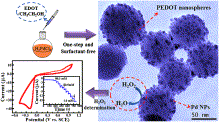A one-pot ‘green’ synthesis of Pd-decorated PEDOT nanospheres for nonenzymatic hydrogen peroxide sensing
Fengxing Jianga, b, Ruirui Yuea, b, Yukou Dua*(杜玉扣), Jingkun Xub, Ping Yanga
a College of Chemistry, Chemical Engineering and Materials Science, Soochow University, Suzhou 215123, PR China
b Jiangxi Key Laboratory of Organic Chemistry, Jiangxi Science and Technology Normal University, Nanchang 330013, PR China
Biosens. Bioelectron. 2013, 44, 127–131.
We developed a novel nonenzymatic biosensor based on palladium/poly(3,4-ethylenedioxythiophene) (Pd/PEDOT) nanocomposite modified glassy carbon electrode (GCE) for the detection of hydrogen peroxide (H2O2). Pd/PEDOT has been successfully fabricated by a facile one-pot ‘green’ method using H2PdCl4 as an oxidant and a source of metal nanoparticles without any surfactants and templates. The as-synthesized PEDOT nanospheres are quite uniform in size (∼60 nm) without aggregation and provide a good platform for anchoring the Pd nanoparticles (NPs). Pd NPs (∼4.5 nm) are homogenously dispersed on surface of PEDOT nanospheres. The Pd/PEDOT nanospheres on GCE exhibit a good electrocatalytic activity towards the H2O2 reduction. The electrochemical response of Pd/PEDOT to H2O2 exhibits a low detection limit of 2.84 μM in the range of 2.5×10−3–1.0 mM with a high sensitivity, good repeatability, acceptable reproducibility and good long-term stability. The good recoveries achieved in spiked human urine samples demonstrated the potential application of Pd/PEDOT for H2O2 detection.

链接://www.sciencedirect.com/science/article/pii/S0956566313000055#f0020
